

Scientists say they finally have 'solid evidence' for Planet X, a true ninth planet on the fringes of our solar system.
The gas giant is thought to be almost as big as Neptune and orbiting billions of miles beyond Neptune's path - distant enough to take 10,000 to 20,000 years to circle the sun.
This Planet 9, as the two Caltech researchers call it, hasn't been spotted yet.
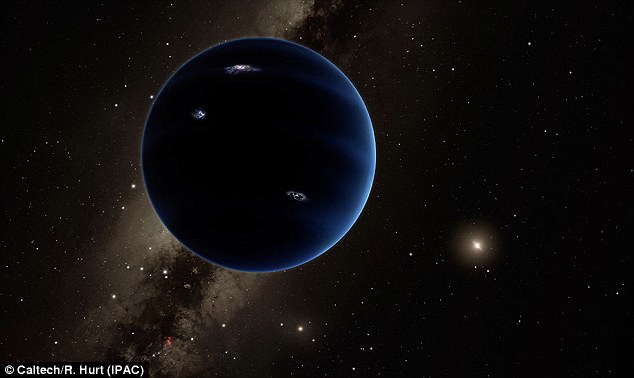
The gas giant is thought to be almost as big as Neptune and orbiting billions of miles beyond Neptune's path — distant enough to take 10,000 to 20,000 years to circle the sun.
They base their findings on mathematical and computer modeling, and anticipate its discovery via telescope within five years.
The two reported on their research Wednesday in the Astronomical Journal because they want people to help them look for it.
'We could have stayed quiet and quietly spent the next five years searching the skies ourselves and hoping to find it.
'But I would rather somebody find it sooner, than me find it later,' astronomer Mike Brown told AP.
'I want to see it. I want to see what it looks like. I want to understand where it is, and I think this will help.'
Researchers inferred Planet X's presence from the peculiar clustering of six previously known objects that orbit beyond Neptune.
They say there's only a 0.007% chance, or about one in 15,000, that the clustering could be a coincidence.
Instead, they say, a planet with the mass of 10 Earths has shepherded the six objects into their strange elliptical orbits, tilted out of the plane of the solar system.
During the solar system's infancy 4.5 billion years ago, they say, the giant planet was knocked out of the planet-forming region near the sun.
Slowed down by gas, the planet settled into a distant elliptical orbit, where it still lurks today.
Once it's detected, the researchers insist there will be no Pluto-style planetary debate.
'This would be a real ninth planet,' says Brown, the Richard and Barbara Rosenberg Professor of Planetary Astronomy.
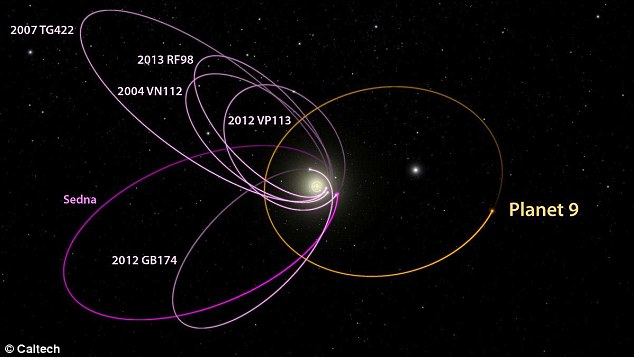
The six most distant known objects in the solar system with orbits exclusively beyond Neptune (magenta) all mysteriously line up in a single direction. Such an orbital alignment can only be maintained by some outside force, Batygin and Brown say. Their paper argues that a planet with 10 times the mass of the earth in a distant eccentric orbit anti-aligned with the other six objects (orange) is required to maintain this configuration.
'There have only been two true planets discovered since ancient times, and this would be a third.
'It's a pretty substantial chunk of our solar system that's still out there to be found, which is pretty exciting.'
They ought to know; one of them, Mike Brown, is the so-called Pluto killer.
'My daughter, Lilah, has suggested that we call it Pluto.
'That way Pluto can be a planet again,' he said of the discovery.
'We have found evidence that there's a giant planet in the outer solar system,' Brown told Popsci.
'By 'giant' we mean the size of Neptune, and when we say 'outer solar system' we mean 10 to 20 times farther away than Pluto.'
Brown and Konstantin Batygin, a theoretical astrophysicist at Caltech who specializes in solar system dynamics, think Planet X formed in the early stages of the solar system, some 4 billion years ago, when the large planets (including Planet X) were still rocky cores.
If Planet X's core had been able to stay in the inner solar system and carry out the rest of its formation, it could have accumulated enough gas or ice to become another giant like Jupiter or Neptune, the pair told Popsci.
But because the large cores of the other planets were packed so tightly in the inner solar system, there wasn't enough room for them all to develop, and Planet X was 'kicked out.
'There would have been a gas nebula around the solar system at the time that would have slowed it down as it plowed through the gas, putting it into this eccentric orbit,' Brown said.
'I could not imagine a bigger deal if—and of course that's a boldface 'if'—if it turns out to be right,' Gregory Laughlin, a planetary scientist at the University of California (UC), Santa Cruz told Science.
'What's thrilling about it is [the planet] is detectable.'
The team has time on the one large telescope in Hawaii that is suited for the search, and they hope other astronomers will join in the hunt.
Subaru, an 8-meter telescope in Hawaii that is owned by Japan. It has enough light-gathering area to detect such a faint object, coupled with a huge field of view—75 times larger than that of a Keck telescope.
'Although we were initially quite skeptical that this planet could exist, as we continued to investigate its orbit and what it would mean for the outer solar system, we become increasingly convinced that it is out there,' says Batygin, an assistant professor of planetary science.
'For the first time in over 150 years, there is solid evidence that the solar system's planetary census is incomplete.'
Meanwhile, Brown and other colleagues have begun searching the skies for Planet Nine.
Only the planet's rough orbit is known, not the precise location of the planet on that elliptical path. If the planet happens to be close to its perihelion, Brown says, astronomers should be able to spot it in images captured by previous surveys.
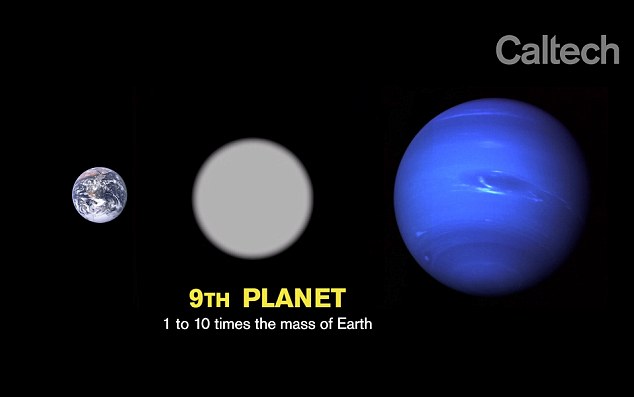
The putative ninth planet—at 5,000 times the mass of Pluto—is sufficiently large that there should be no debate about whether it is a true planet.
If it is in the most distant part of its orbit, the world's largest telescopes—such as the twin 10-meter telescopes at the W. M. Keck Observatory and the Subaru Telescope, all on Mauna Kea in Hawaii—will be needed to see it.
If, however, Planet Nine is now located anywhere in between, many telescopes have a shot at finding it.
'I would love to find it,' says Brown.
'But I'd also be perfectly happy if someone else found it. That is why we're publishing this paper. We hope that other people are going to get inspired and start searching.'
In terms of understanding more about the solar system's context in the rest of the universe, Batygin says that in a couple of ways, this ninth planet that seems like such an oddball to us would actually make our solar system more similar to the other planetary systems that astronomers are finding around other stars.
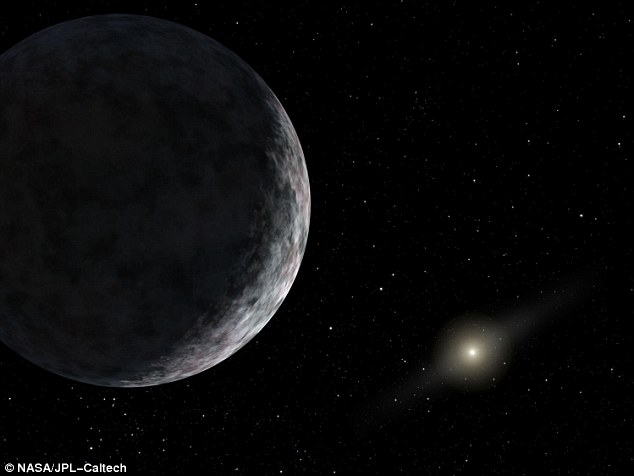
If, however, Planet Nine is now located anywhere in between, many telescopes have a shot at finding it.
First, most of the planets around other sunlike stars have no single orbital range—that is, some orbit extremely close to their host stars while others follow exceptionally distant orbits. Second, the most common planets around other stars range between 1 and 10 Earth-masses.
'One of the most startling discoveries about other planetary systems has been that the most common type of planet out there has a mass between that of Earth and that of Neptune,' says Batygin.
'Until now, we've thought that the solar system was lacking in this most common type of planet. Maybe we're more normal after all.'
Brown, well known for the significant role he played in the demotion of Pluto from a planet to a dwarf planet adds, 'All those people who are mad that Pluto is no longer a planet can be thrilled to know that there is a real planet out there still to be found,' he says.
'Now we can go and find this planet and make the solar system have nine planets once again.'
Day|Week

 Chinese pole dancing master opens class in Tianjin
Chinese pole dancing master opens class in Tianjin The most beautiful town of snow in China
The most beautiful town of snow in China SWAT members hold romantic wedding in E China
SWAT members hold romantic wedding in E China Breathtaking scenery and simple lifestyle in Hainan
Breathtaking scenery and simple lifestyle in Hainan Finding sexiest underwear supermodels
Finding sexiest underwear supermodels Top 10 ancient pagodas in China
Top 10 ancient pagodas in China Chinese version of Victoria's Secret Show held in Hunan
Chinese version of Victoria's Secret Show held in Hunan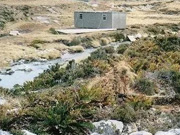 Can you find out the sniper hiding in camouflage?
Can you find out the sniper hiding in camouflage? Spectacular rockets launch scenes
Spectacular rockets launch scenes Spectacular aerial photos of the Three Gorges
Spectacular aerial photos of the Three Gorges